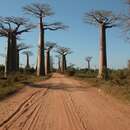Biology
provided by Arkive
The long-lived Grandidier's baobab is in leaf from October to May, and flowers between May and August (2). The flowers, said to smell of sour watermelon, open just before or soon after dusk, and all the pollen is released during the first night (2). It is pollinated by nocturnal mammals, such as fork-marked lemurs. They move through the canopies, inserting their snouts into the white flowers and licking nectar from the petal bases, resulting in pollen being deposited in the lemur's face (3).
Grandidier's baobab bears ripe fruit in November and December (2). Unlike the baobabs of Africa and Australia, it appears that the seeds of the tasty fruit are not dispersed by animals. Lemurs are the only living animals on Madagascar that are capable of acting as seed dispersers, yet this has never been documented (2). In the past however, this could have been very different. There are several species that became extinct since human colonisation of the island, 1,500 to 2,000 years ago, that could very likely have been dispersers of the seeds. This includes species of primates that were thought to be similar to baboons, and the heaviest bird that ever lived, the elephant bird, which had a powerful beak that could have opened large fruit (2). Today, water may be the means by which the seeds are dispersed (2).
On the tropical island of Madagascar, a lack of water can sometimes be a problem for its inhabitants. It appears that the baobab overcomes this by storing water within the fibrous wood of the trunk, as the tree's diameter fluctuates with rainfall (2).
Conservation
provided by Arkive
Numerous non-governmental organisations and scientists, along with the Malagasy government, realise the importance of conserving the unique biodiversity of Madagascar and are working to protect this magnificent island and its diverse fauna and flora (4). One measure, from which Grandidier's baobab is likely to benefit, is the designation of protected areas. In 2003 the President of Madagascar vowed to triple the amount of protected areas (5); a pledge that won't only help the magnificent giant baobab, but also the Malagasy people, whose livelihoods depend on the preservation of their watersheds and forests.
Description
provided by Arkive
This imposing and unusual tree occurs only on the island of Madagascar, where it is threatened by the encroachment of agricultural land. There are eight species of baobabs, six of which are endemic to Madagascar (3); Adansonia grandidieri is the strangest and most magnificent of them all. They have massive cylindrical trunks, up to three meters across, covered with smooth, reddish-grey bark (2). At certain times of the year the flat-topped crowns bear bluish-green palmate leaves, dark brown floral buds or spectacular flowers with white petals (2). The large, dry fruits of the baobab contain kidney-shaped seeds within an edible pulp (3).
Habitat
provided by Arkive
Grandidier's baobab used to inhabit dry, deciduous forest, especially near seasonal rivers or lakes. However, today it is mainly found in open, agricultural land or degraded scrub (2).
Range
provided by Arkive
Occurs in south-western Madagascar between Lac Ihotry (near Morombe) and Bereboka (2).
Status
provided by Arkive
Classified as Endangered by the IUCN Red List 2006 (1).
Threats
provided by Arkive
Adansonia grandidieri is the most heavily exploited of all the Malagasy baobabs (2). The seeds and the vitamin C-rich fruit pulp are eaten fresh, and cooking oil is extracted from the oil-rich seeds. The fruit is either collected from the ground, or wooden pegs are hammered into the trunk so the tree can be climbed to collect the fruit (2). The thick bark of the baobab is composed of tough long fibres that can be used to make ropes, and the majority of trees bear scars from where the bark was cut from ground level to about two meters to obtain this material (2). The spongy wood is comprised of sheets of fibre that are collected from dead or living trees, dried in the sun and sold for thatch (2). Most of these varied uses do not involve the tree being killed, and thus are unlikely to pose a great threat to the baobab. The greatest threat to this species has come from the transformation of its forest habitat into agricultural land. Within these disturbed habitats, there is a noticeable lack of young trees. Fires, seed predation, competition from weeds and an altered physical environment might be affecting the ability of the Madagacar baobab to reproduce (2), which may have devastating consequences for its survival.

